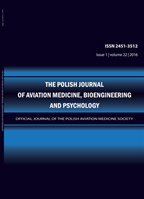2020, Volume 26, Issue 3
SIMULATOR SICKNESS AND ITS RELATIONSHIP TO OCULOMOTOR ACTIVITY – COMPARISONS OF A FIXEDBASE VS. FULL-MOTION SIMULATOR
MARCIN BIERNACKI1
-------------------------------------------------------------------------------------------------
1Department of Aviation Psychology, Military Institute of Aviation Medicine
Autor korenspondencyjny: MARCIN BIERNACKI; Department of Aviation Psychology, Military Institute of Aviation Medicine; email: mbiernacki@wiml.waw.pl
Full text
Streszczenie
Introduction: Studies on simulator sickness take into account an increasing number of factors regarding individual characteristics (e.g., gender, age, experience), testing time as well as simulator testing conditions, to name a few. In addition to the symptoms of simulator sickness expressed at the level of subjective indicators, it is also important to consider physiological indicators. The present study was designed to test whether the use of a fixed-base vs. fullmotion simulator influences the severity of simulator sickness symptoms and changes in the level of oculomotor variables.
Methods: Twelve male subjects with age M=29.8, SD=4.26 participated in this study. Each subject performed two 30-minute simulator tasks following the same route. Each of these tasks was performed in different configuration of a truck simulator manufactured by ETCPZL Aerospace Industries: Condition 1 – fixed-base simulator, Condition 2 – full-motion simulator. Eye movements were recorded during the simulator task. Additionally, the SSQ questionnaire was filled out immediately after the simulator task and 1 h after leaving the simulator.
Results: The results show a higher level of most symptoms of simulator sickness under 2nd condition (full-motion simulator). In the case of measurement immediately after completing the task on the simulator, there was an increase in oculomotor problems. On the other hand, the measurement after 1 h also revealed a significant increase in nausea, oculomotor and disorientation. Moreover, after 1 hour, a relationship between nausea symptoms and oculomotor indices was found.
Discussion and Conclusions: Results indicate the influence of simulator testing conditions on the occurrence of simulator sickness symptoms. In addition, the relationship between variables measured by the oculograph and subjective symptoms of simulator sickness was demonstrated. The results obtained indicate changes in the sensitivity of physiological indicators and are discussed in the context of the possibility of using simulators in the diagnosis and training of selected functions.
Słowa kluczowe
physiological variables, simulators, simulator sickness
